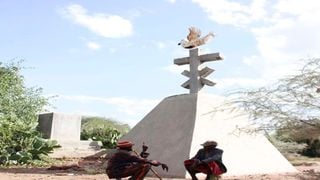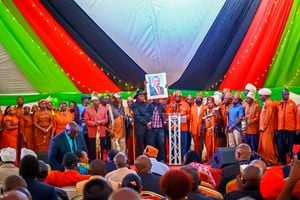
Kollowa Massacre survivors Akodo Lotigaw (right) and Losikayang Bokong sit beneath the monument built in memory of the Pokot victims in Kollowa, Tiaty Sub-county, on January 28, 2016.
| File | Nation Media GroupWest Pokot
Premium
Pokot dead who refuse to lie silently in their graves
They were supposed to be buried in an unmarked grave and forgotten.
But today, just 300 metres from the dusty Kollowa shopping centre in Baringo East, stand two monuments—one for the victims and the other for their killers.
The Kollowa Massacre is hardly spoken about, but the Pokot community wants to reopen the matter and force the British pay for the killings that occurred in the 1950s as colonial police confronted followers of the proscribed Dini ya Msambwa sect.
The two pillars, though constructed in two different eras by different groups of people, are the only reminder of that dark moment in history.
While the colonial government recorded it as the Kollowa Affray, and conducted an inquiry, the community is still unhappy. It wants the British government to pay for killing its members.
While the British memorialised the police officers who were killed by erecting a pillar in Kollowa, it was not until 2016 that a statue was put up in memory of the victims by adherents of Dini ya Roho Mafuta Pole ya Africa.
Previously, the pillar with an epitaph bearing the names of the four officers—District Officer Allan Stevens, Assistant Superintendent of Police George Taylor, Assistant Inspector of Police Robert Cameron, and policeman Kipkonge Kobirir—had stood here as a sign of selective memory. But behind it, is a mass grave where all those who died were buried.
Inscribed on the new pillar are 45 names of the massacre victims, although the local residents and historians give numbers as ranging between 45 and 100.
The white pillar, which is about four meters tall with two crosses on top and the sculpture of a dove at the apex, was unveiled on April 24, 2016, by then-West Pokot Governor Simon Kachapin.
Followers of Dini ya Roho Mafuta Pole ya Africa were shot dead by British soldiers on April 24, 1950, while on a pilgrimage to Mt Elgon, which they called Zion, led by Lukas Pkech.
Dini ya Msambwa
Pkech was a Pokot evangelist whose teachings were founded on the traditional ways of worship and was said to be a follower of Dini ya Msambwa, which was led by the controversial cleric Elijah Masinde.
Dini ya Msambwa, which translates to “religion of the ancestral spirits” had been declared illegal in 1948 and Masinde arrested and deported to Lamu. According to historian Zebulon Dingley, the movement developed out of protracted religious debates among former Quaker converts in the North Kavirondo District (now Bungoma County) in the late 1930s and early 1940s.
“It was self-consciously a ‘return’ to pre-colonial Bukusu religion,” noted Dingley.
It is claimed that the activities of the Pokot spiritual leader and the suspicion of a planned uprising were at the centre of the controversy surrounding the massacre. Pkech’s teachings and growing influence among the locals had placed him in direct conflict with the colonial administration in Baringo, led by the DO, Stevens. Historian Erling Lundeby in his journal article “Lukas Pkech:Violent Political Rebel or Christian Spiritual Leader?”, says Pkech considered himself a prophet and his evangelical message promised a very bright future for those who accepted his message.
“His message can be summarised as eternal life, freedom from European control, restoration of traditional customs, immunity from sickness, relief from blindness, immunity from gunfire, immunity from capture, increased fertility for old men, and no barrenness for women,” notes Lundeby.
In the events leading to the clash, Pkech is said to have mobilised his followers to embark on a prayer pilgrimage to Mt Elgon, and upon reaching Kollowa near Kerio Valley, they decided to rest.
Dingley puts the date at April 24, 1950, and adds that the intention by the pilgrims was to rest for the night before continuing on their journey.
Pkech’s session was, however, cut short by the arrival of Stevens and Arthur Simpson, who commanded two lorries full of armed colonial Administration Police officers. The mission by Simpson, who was also accompanied by two local chiefs—Lobon and Engeleyo—was to arrest Pkech and disperse the crowd.
Dingley explained that the police had been pursuing Pkech for having escaped from a prison in Nakuru a few months earlier.
“Pkech was convicted in 1949 of being a member of an unlawful society (Dini ya Msambwa) and sentenced to 30 months’ imprisonment with hard labour. Eleven months later, he escaped and resumed preaching almost immediately under the name Arususu,” said Dingley.
However, the operation by the British is said to have spiralled out of control following a communication breakdown that saw police open fire on the sect members during a confrontation.
The account of who exactly sparked the violence differs on both sides, with each accusing the other of starting the fight.
Simpson, while testifying before the commission of inquiry into the Kollowa Affray, said the Pokot had overrun the police defence lines, causing confusion that prompted the police to open fire.
He defended himself, saying the Pokot, who were armed with spears, had ignored the warning shots and overrun three defensive lines.
“At this point, the Pokot began to spread out in what Simpson believed to be an attack formation. Lobon and Engeleyo ran in one direction and Simpson and his interpreter in the other, with Simpson giving Taylor the order to fire as he did,” said Dingley.
Pkech was among the first to be killed and his body was identified among the dead. Survivors said he was shot on the forehead.
According to an account by the members of Dini ya Roho Mafuta Pole, Pkech only wanted to be left alone to preach in peace.
The ministry’s current leader, Apostle Aristica Kitilil Kapel, who spoke to Nation, said Pkech had asked his people to remain behind so that he could reach a peace deal with the British.
Kitilil explained that some of Pkech’s followers, however, feared for his safety and decided to follow him.
“It was after they shot Pkech that the crowd got furious and decided to take revenge. However, the police who had guns sprayed bullets on our people, killing so many of them,” said Kitilil.
Upon seeing their colleagues dropping dead, other members ran for safety. And when the dust settled, a massacre has happened. Some locals claim it is Pkech who had incited his followers to face the colonialists and take power from them.
Lotikaw Lokodo, who lost his grandfather Pkirket Losuker, said Pkech had promised his followers that they were going to the land of milk and honey.
“In his many secret teachings, Pkech told his followers that bullets would change to water. He instructed them to drop their swords and grab the colonial administrator with bare hands and that’s when bullets started raining on them,” he said Lokodo.
William Kiptulo, 75, was a 5-year-old boy then, but still recalls the many bodies that he encountered in the fields after the shooting. He says he remembers the story because the mouths of the people never stopped telling it. He recalls seeing many bodies, some which were being eaten by hyenas.
“There was a stench all over. The corpses were scattered all over the place as animals feasted on them,” said Kiptulo.
Later, the colonialists brought tractors, collected all the bodies and buried them in a mass grave. The top of the grave was covered with stones, which are visible to date.
The steps taken by the British in the aftermath of the massacre still remain a painful memory for the Pokot and the followers of Dini ya Roho Mafuta Pole.
The unfair trials and imprisonment of members, as well as the communal punishment, including huge fines and forced labour, have shaped the socio-economic life of the Pokots in different ways.
According to Dingley, the government, blaming the community for the violence, took punitive measures, which left the community poor, fearful and families shattered.
Each household was required to pay at least 200 head of cattle and relatives of the victims of the massacre were subjected to forced labour.
There was also an additional fine of 600 cows from the Loyamorok chief and 400 from his Tirioko counterpart after they were accused of collaborating with Pkech, for failing to report his activities.
“Over the course of the following year, more than 5,600 head of cattle were confiscated from Baringo District residents. But it was understood locally as compensation to the families of the Whites who had been killed, in keeping with Pokot norms of ‘blood debt’ compensation,” stated Dingley.
The members of the religious movement were arrested and sentenced to long jail terms with hard labour. Upon their release, some of Pkech’s followers regrouped and began the Dini ya Roho Mafuta Pole ya Africa.
According to Kitilil, one of Pkech’s assistants—Rosti Achulo—who was arrested in 1957 and jailed for 25 years, founded the Dini ya Roho Mafuta Pole ya Africa upon his release.
The church was registered in 2012 after a long struggle with the government and in 2016, it proceeded to erect a monument in memory of its founder.
On April 24, each year, thousands of Dini ya Roho Mafuta Pole ya Africa followers gather at Kollowa to pray and perform rituals in memory of Pkech.





